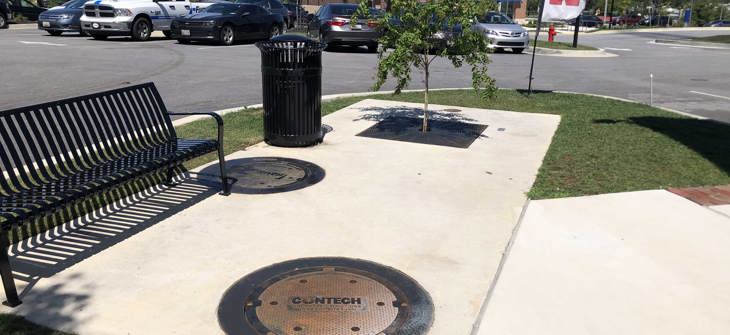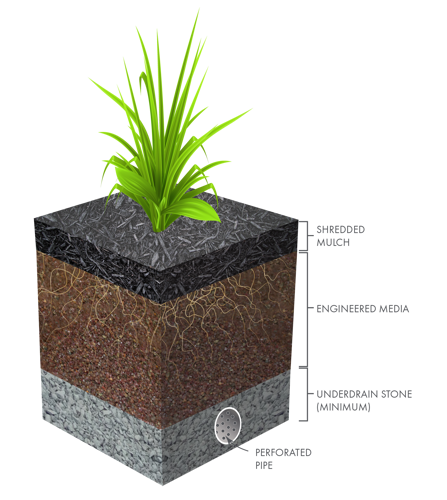
5 Components of a High-Rate Bioretention System
To understand the physical and biological processes in a high-rate biofiltration system, it’s necessary to look at how each system component contributes to pollutant removal and flow management. If you are not familiar with high-rate biofiltration – check out this blog post for an in-depth explanation.

Mulch
Often seen as just an aesthetic feature, mulch provides physical filtration and acts as a pretreatment and anti-scour layer for the media. In addition, the mulch layer protects biofiltration media from occlusion by capturing sediment loads and debris. In addition, mulch provides benefits beyond pretreatment. Since the mulch is made from organic material, as it biodegrades, it releases new organic material into the media, which helps regenerate the media and sustain the biological processes taking place within the media. The mulch also provides water retention for the system’s vegetation. The mulch is the only component of the system that needs to be replaced regularly, usually one to two times per year.
Engineered Media
After the mulch layer, water flows through a media layer, which filters fine pollutants and nutrients through physical and chemical processes.
Components of engineered bioretention media support both inter-and intra-storm treatment processes. Aggregates in the engineered media increase and maintain flow rate and provide aeration to vegetative roots. Organic matter retains moisture, provides carbon to the microbial community, supports vegetative growth and enhances pollutant removal. These components support inert and reactive filtration during storm events as well as the biological transformations and sequestration that occur between storm events.
If the mulch layer is maintained correctly, the high-flow media will not need to be replaced. The chemical and biological processes between the media and the vegetation will continually regenerate the media.
Plants
Most of the biological processes for which biofilters are named occur underground in the rhizosphere. The rhizosphere is the habitat where the plant root system interacts with microorganisms that degrade and transfer pollutants into less-toxic forms, which the plant then can uptake and sequester through carbon and nutrient assimilation.
Plants help maintain the permeability of the media through their expanding root systems. Roots shrink and swell during wetting and drying cycles, keeping the filtration media aerated.
Plants also play a vital role in the long-term sustainability of the filtration media. As the filter media captures and immobilizes pollutants, those pollutants are decomposed, volatilized and incorporated into the biomass of the system’s micro/macro fauna and flora. In addition, the cycling effect in which pollutants enter the system, are biodegraded by the microorganisms in the soil, and then are taken up into the vegetation helps regenerate the media for the next rain event, as there are more reaction sites available for new pollutants that enter the system.
Stone and Underdrain
All high-rate biofiltration systems are designed to drain down via infiltration into the surrounding soils or through an underdrain. This drain down is needed to ensure there’s no standing water in the media for long periods. If the surrounding soil can’t accept the runoff, an underdrain is needed to allow the water to drain down. Proper sizing of the underdrain is vital due to the high flow rates the system will encounter.
Containment Structure
Many high-rate biofiltration systems come pre-packaged as a complete system in a concrete containment structure. These structures can be designed with or without a top slab and tree grate. The structure’s purpose is to house the internal components and enable fast installation. Large systems (generally greater than 300 square feet) can be designed without a containment structure, as the structure would be too large to manufacture and ship.

